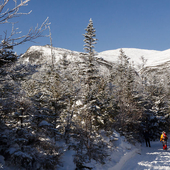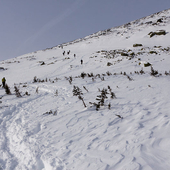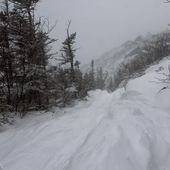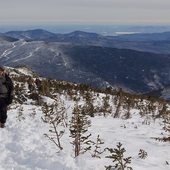Last year I did an intro to mountaineering class which really kicked my butt. Even though it was hard, cold, and uncomfortable I knew I wanted to try it again. Over the summer and fall I started gearing up in anticipation of doing some trips this winter. My co-worker, Chris, suggested we try Mt. Washington in January as an overnight trip. It sounded like a good idea to me. I called up another friend, Matt, who has had some success in summiting Mt. Washington in the winter to see if he’d be interested too–which he was.
Anyone reading this likely is aware of Mt. Washington’s status as one of the most dangerous mountains in the US. Well over 100 people have died on its slopes since 1849. It has extremely variable weather. High winds and freezing temps are possible even through the summer. Check out the Mt. Washington Observatory website to see what I mean. Summiting in winter is part preparation and a big chunk of luck with the weather.
…
The three of us headed up to Manchester to crash at my parent’s place on Friday, Jan. 14th. This gave us a decent place to get up early and summit over the weekend. On Friday night we checked the forecast and were in luck. Saturday was to be clear, moderate temps (mid-single digits), and light winds (15-25 mph). We decided that we’d hike from Pinkham Notch to Hermit Lake Shelters to drop off our overnight gear then head for the summit.
From the AMC Pinkham Notch Visitor Center the three of us headed up Tuckerman’s Ravine trail. Matt started a few minutes ahead of Chris and me so that he would get to the shelter and reserve us spots. The weather was brisk but clear and calm. As such there were plenty of others on the well groomed trail up to Hermit Lake. It was so clear that the bright white summit was set against a backdrop of cloudless blue sky.
The weather was brisk but clear and calm. As such there were plenty of others on the well groomed trail up to Hermit Lake. It was so clear that the bright white summit was set against a backdrop of cloudless blue sky.
The trail up to Hermit Lake is used for the avalanche rangers and they head up in a snowcat so the trail is well defined and groomed from many passages of the snowcat, as such crampons weren’t necessary. Starting at 9am Chris and me got to the shelter around 10:45am, which is 2.5 miles and 1800 ft of elevation. After dropping off our stuff and eating a quick bite the three of us headed back towards the Lion’s Head Summer route at 11:20am. Normally the Winter Route is the standard trail to the summit for Washington in the winter. However this year the mountain is way behind on snowfall totals.
Lion’s Head trail is where the real climbing started. For this trail we needed our crampons. The trail snaked back and forth with switchbacks trying to keep the grade of the trail reasonable. Even at this point the weather was still great with little to no wind and bright sunshine. Progressing higher we reached more moderate terrain, but it never backed off on its climb upwards.
Lion’s Head Trail is named after a large pile of rocks on the mountain that resembles its namesake. It is at Lion’s Head that you can tell if your trip to the summit will be easy or hard. The prevailing winds are from the roughly from the west. The Lion’s Head and the ridge it sits on shelters the trail. Once reaching Lion’s head we could see that our beautiful day was starting to slip away as the forecast had predicted. The sky became a little less blue, not that there were approaching clouds so much, but more because the clouds just form because of the mountain. Moving around the Lion’s Head we were exposed to the winds which had picked up from earlier in the day to around 20-25 mph, with slightly higher gusts. Just before this we suited up in anticipation of the wind and it was good we did.
Once passing around Lion’s Head there is a long relatively flat section of the trail that goes passed the  Alpine Garden. This is just a breather for the summit cone that is to the right and straight ahead. To the left, Tuckerman’s Ravine drops abruptly and the floor is out of site. Route finding on this day was quite easy since there were probably 100 other people who were summiting that day. Well worn paths leading by the cairns were easy to follow. After passing the Alpine Garden and up the next ridge the full force of the wind was at our left (west). This is also were the trail becomes steeper. Plodding onwards the blue skies disappeared and snow began to fall. Fall is a relative term since it was around 25-30 mph winds.
Alpine Garden. This is just a breather for the summit cone that is to the right and straight ahead. To the left, Tuckerman’s Ravine drops abruptly and the floor is out of site. Route finding on this day was quite easy since there were probably 100 other people who were summiting that day. Well worn paths leading by the cairns were easy to follow. After passing the Alpine Garden and up the next ridge the full force of the wind was at our left (west). This is also were the trail becomes steeper. Plodding onwards the blue skies disappeared and snow began to fall. Fall is a relative term since it was around 25-30 mph winds.
After making the final plod up the snow field you reach the summit and the buildings which are there. I typically check the weather on the summit every morning when I get to work and look at the webcams. It was satisfying to see the observatory, the A frame, and the observation deck in person for the first time. After some quick pictures and a couple snacks in the lee of a building we headed back down. In all it took us 2:40 to get to the summit from the shelters. Not a blistering pace but not bad. Of everyone who summited we were in the last 15-20% of the people who did that day. It is too bad that we didn’t get up there sooner for the 120 mile visibility.
The shelters at Hermit Lake sleep up to 86 people. There are a mix of 3-wall and 4-wall shelters. We were able to get a 4-wall because of Matt’s quick pace in the morning. These 4-walls have two sliding doors at either end that seal out the wind and some of the cold during the night. Luckily/unluckily we were joined by a group from Ohio State who were planning to summit the next day. On one hand we had a full shelter which increased the temps inside 10-20 degrees over what it was outside, which was good because the wind continued to pick up during the night and we got 3-4 inches of snow. But obviously we had snorers and lots of people getting up at 4:00am to make a summit attempt.
 Since we had accomplished our mission Sunday was an easy day. Matt opted to see how far he could get up the summit again before the weather turned him around. Chris and me headed up to the base of Tuckerman’s Ravine. This trail is only 0.7 of a mile from the shelters but has a fair amount of elevation. I really liked the hike because the snow was flying and the trail was only broken by one other pair of footsteps.
Since we had accomplished our mission Sunday was an easy day. Matt opted to see how far he could get up the summit again before the weather turned him around. Chris and me headed up to the base of Tuckerman’s Ravine. This trail is only 0.7 of a mile from the shelters but has a fair amount of elevation. I really liked the hike because the snow was flying and the trail was only broken by one other pair of footsteps.
This was my first summit of Mt. Washington, winter or summer, and it was satisfying. Before reaching Lion’s Head I almost thought it too easy. Not that I wasn’t tired, but the weather was just so cooperative. After getting around Lion’s Head I felt a little more satisfied that we didn’t a “gimme” summit.

